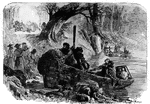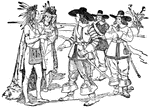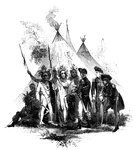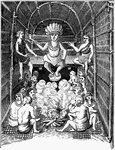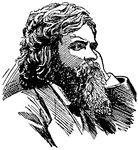
Edward Eggleston
(1837-1902) American author that wrote biographies of American Indians and the History of the United…
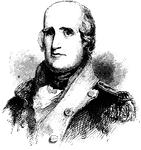
Major George Rogers Clark
(1752-1818) Surveyor and soldier of the Revolutionary war. Led a militia group in Kentucky and after…

Manhattan Island Before the Dutch Settlement
Native American dwellings on Manhattan Island, before the Dutch settlement

Elliot, Apostle of the Indians, Preaching to His flock
John Elliot preaching to a group of Native Americans.

Penn's Treaty with the Native Americans under the Elm Tree at Shackamaxon
Penn's Treaty with the Native Americans under the Elm Tree at Shackamaxon

George Custer
"General George A. Custer, born in New Rumley, Harrison County, Ohio, December 5th, 1839, died in Montana,…

Delaware Indians
"Delaware Indians acting as scouts for the Federal army in the West. General Fremont, on taking command…

General George D. Bayard
"General Bayard, born in Seneca Falls, N. Y., December 18th 1835, died December 14th, 1862, was graduated…

General Christopher C. Augur
"General Augur, born in New York in 1821, was graduated from the United States Military Academy in 1843.…

Canada Lynx
"The Canada Lynx of the Indians, has a round, broad head, large eyes, strong teeth, ears acute and tipped…

Sewellel
"It is about the same size of the gray rabbit, being fourteen inches long with a tail half an inch long.…

War Dance
"Camp life in the West. During one of the pauses in the active part of the Missouri campaign our special…

Waterhouse's Battery
"Waterhouse's Battery, Sherman's Corps, before Vicksburg. The interior view of Waterhouse's battery,…

Thayendanegea
"Joseph Brant or Thayendanegea, part of the Wabash Indians."—E. Benjamin Andrews, 1895

Bloody Run
Bloody Run, a stream which comes leaping in sparkling cascades from the hills, and affords fine trout…

Sabbath Day Point
Sabbath Day Point. It is between three and four miles from the little village of Hague, in the midst…

Toby's Eddy
View near Toby's Eddy. The Moravians had established six missionary settlements in the vicinity of the…

Delaware Indians
"Delaware Indians acting as scouts for the Federal army in the West. General Fremont, on taking command…

Delaware Indians
"Delaware Indians acting as scouts for the Federal army in the West. General Fremont, on taking command…

Delaware Indians
"Delaware Indians acting as scouts for the Federal army in the West. General Fremont, on taking command…

Buffalo
"The Buffalo. As the game upon which they depended moved about the country, so the Indians roved in…

Western Train
"A western emigrant train. The occupation of the west. With every year the line of settlements was pushed…

Dakota Chief
"Dakota, or Dakotah is the name by which the Sioux Indians call themselves."—(Charles Leonard-Stuart,…

Wapiti
"Wapiti is the name given by the North American Indians to an animal, a native of North America, ranging…

Nelumbium
"Nelumbium is the typical and only genus of the order Nelumbiaceæ. The species are remarkable…

Monilia
"A necklace. Necklaces were worn by both sexes among the most polished of those nations which the Greeks…




